When I’m thinking up recipes, I’m trying to satisfy a craving,” says Claire Ptak, founder of Violet Cakes in east London. Her command of flavours and textures and the outright beauty of her creations has made her one of London’s best-loved bakers, sought after by Hackney residents and royalty alike. But the craving comes first. “In the mornings, it’s cake,” she says. “I’m a total cake-for-breakfast person, donuts too.”
Her new book, Love is a Pink Cake, was originally going to be a seasonal baking manual, requiring photoshoots for each season, but Covid restrictions got in the way so Ptak simplified it and made it more personal. Now the book is divided between London, where she has lived since 2005, and northern California, where she was born and raised.
“We’d always be in the woods looking for mushrooms and wild berries,” she recalls of her childhood in the small, arty town of Inverness, north of San Francisco. Her parents were good cooks and Ptak adored baking from a young age, though for a long time she wanted to become a film-maker. An encounter with a pastry chef from Chez Panisse changed her mind and she landed a job at the renowned Berkeley restaurant, baking wild huckleberry tartlets for her interview.
Three years later she moved to London and set up Violet, which began as a cake stall on Broadway Market before graduating to a nearby building in 2010. When she first arrived, Ptak would make “lots of Christmassy things – cakes, puddings, mince pies – and desserts like trifle and posset. They really blew me away, I thought they were incredible.”
Later, she went back to her roots and embraced a more Californian approach, but with British ingredients. “There’s a slightly lighter touch with certain things,” she says of her style of baking. Seasonality and freshness are important too, as is preserving the integrity of the ingredients – making them “taste more like themselves” by playing with flavours and textures, and lifting them with salts, sugars, acids and fats.
She loved shooting the Californian half of the book over a balmy week in August 2021 at the wood-cabin home of the late sculptor JB Blunk, the father of a childhood friend, but she’s always happy to come back to London. Her love of British baking is still evident in recipes for brown sugar victoria sponge and treacle tart.
The most involved recipe in the book is also her best known. In 2018, Meghan Markle and Prince Harry hired Ptak to bake their wedding cake. She gave them six options and they chose the lemon and elderflower one. “I really loved doing that,” she says. “I felt a real down-to-earth rapport with them. And I thank them very much because my business definitely quadrupled.”
At the heart of Ptak’s book is the idea that baking is an act of love. “I do think that’s true,” she says. “You put so much of yourself into baking something, even if it’s a batch of cookies that takes half an hour. It’s such a caring, thoughtful thing to do. Cake is such a positive thing.”
On measurements
At Violet we weigh everything, including liquids. I suggest you do this at home, too. If you haven’t got one already, invest in a small set of digital kitchen scales.
Chocolate hazelnut cake
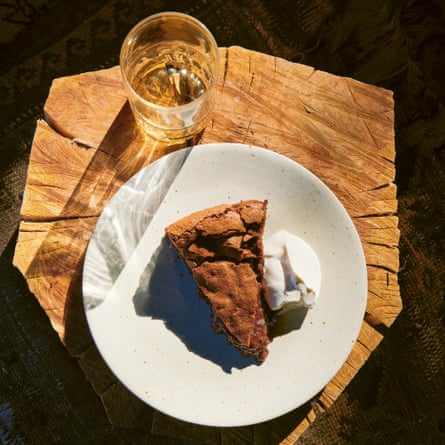
This is inspired by my favourite cake at the River Cafe. My friend Ruthie Rogers (the restaurant’s cofounder) always makes each guest feel like the most important person in the room. When I first moved to London, I tried to get a job at her restaurant but, at the time, they didn’t have a pastry team, so I ended up answering phones. When the other cofounder, Rose Gray, saw me she asked what the hell I was doing there – not only was I terrible at phones, but I belonged in the kitchen. Now, 18 years later, they have a full pastry team, and I tease Ruthie that I should apply for a job.
Serves 8
whole hazelnuts 250g, skins on
dark chocolate 250g
unsalted butter 250g
eggs 6, at room temperature
fine sea salt ½ tsp
caster sugar 250g
flaky sea salt ¼ tsp, for top
creme fraiche or whipped cream to serve
Preheat the oven to 150C fan/gas mark 3½ and grease and line a 20cm cake tin with baking paper.
I recommend using whole hazelnuts with the skins on and going through the process of toasting and removing the skins yourself. You can buy toasted blanched hazelnuts but the flavour is inferior as they deteriorate much quicker once toasted and so inevitably taste slightly stale. Toast the hazelnuts on a baking tray until deep golden and the skins are cracking off – about 15 minutes. (Watch they don’t burn as this will spoil the flavour of the cake.)
Remove the nuts from the oven and turn them out on to a clean tea towel. Bring up the sides of the towel to make a little satchel and rub the nuts together to slough off the skins as much as possible. Open the cloth up and carefully lift out the toasted nuts, leaving behind as much of the skins as possible. Place the skinned toasted nuts into a food processor and blitz until roughly chopped but not a powder. Set aside.
In a heatproof bowl set over a pot of simmering water (make sure the bottom of the bowl is not touching the water), melt the chocolate and butter, stirring occasionally. Once melted, remove from the heat and allow to cool slightly, but keep away from draughts.
Meanwhile, in the bowl of a stand mixer fitted with the whisk attachment, whip up the eggs and fine sea salt until frothy, then slowly add the sugar in a couple of batches. Whip until fluffy and voluminous.
Stir the chopped hazelnuts into the melted chocolate and butter mixture. Finally, fold in the whipped eggs and sugar. Pour into the prepared cake tin and sprinkle the top with the flaky sea salt. Bake for 30 minutes until set but not dry. You want the centre to be a little wobbly and gooey; it will continue to bake and set as it cools, so don’t look for a clean skewer test here. Cool for at least an hour before cutting and serving with the creme fraiche or softly whipped cream.
Raspberries baked in muscat sabayon
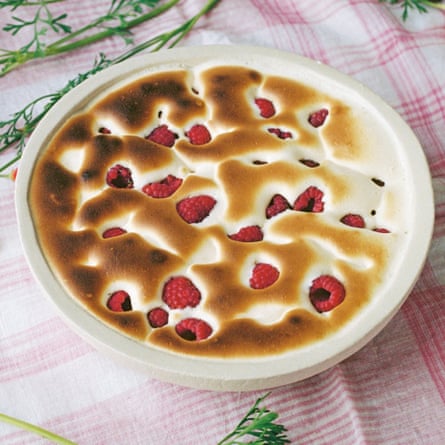
Make sure to buy a good sweet wine as it is the basis of the flavour in this delicate dessert. It’s super fast to make but really can’t be made ahead of time, so pour your guests another drink, excuse yourself from the table and get to work. It should only take about 15 minutes all together.
Serves 4
muscat wine 8 tbsp (beaumes de venise or another sweet dessert wine, such as sauternes)
caster sugar 6 tbsp
egg yolks 6
raspberries 400g
Baker’s tip: never leave egg yolks and sugar sitting in the same bowl before whisking as the acidity of the sugar can burn the yolks and make them grainy. Always combine the ingredients just before whisking and then use straight away.
Get a medium-sized ovenproof gratin dish ready.
Pour the wine and half the sugar into a small, heavy-based saucepan and heat gently until reduced by half. This should take about 10 minutes. Set aside but keep warm.
Place the egg yolks and remaining sugar in the bowl of a stand mixer and whisk until thick and leaving a ribbon trail. Remove from the mixer, then temper them by adding just a few tablespoons of the warm wine mixture and whisking until smooth. Whisk in the remaining wine, being careful not to cook the eggs.
If your mixing bowl is heatproof use it for the next step; or transfer the mixture to a heatproof bowl and place it over a small saucepan of barely simmering water, making sure the base of the bowl doesn’t touch the water. Whisk until the mixture is beginning to thicken and is light and foamy.
Meanwhile preheat the grill to high. Pour the mixture into your gratin dish and scatter the raspberries over the top, then place under the hot grill for a couple of minutes to brown. Serve at once.
Brown sugar victoria sponge
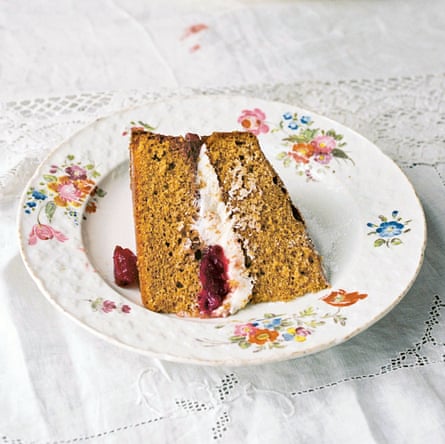
This golden brown, less refined version of victoria sponge has a wonderful texture. I love it with my quick strawberry jam – strawberries and brown sugar are very good friends. A layer of whipped, unsweetened cream in the middle balances out the cake perfectly.
Serves 8-10
For the quick strawberry jam
strawberries 250g, hulled and quartered (cut smaller if the berries are very large)
demerara or raw sugar 225g
lemon juice of 1
salt a pinch
For the sponge
unsalted butter 250g, at room temperature
brown sugar 250g
eggs 4
plain flour 250g
baking powder 1 tbsp
salt ½ tsp
To assemble
quick strawberry jam 150g
double cream 230g
icing sugar for dusting
First make the jam. Put 125g of the strawberries with half of the demerara sugar in a small heavy-bottomed pot and crush with a potato masher (or similar) while warming through over a low heat.
Preheat the oven to 180C fan/gas mark 6 and line a roasting tin with baking paper. Put the remaining demerara sugar in the lined roasting tin and bake in the oven for 10-15 minutes to warm through.
Add the remaining strawberries to the crushed ones, bring it just to a simmer, then add the warm sugar. The warm sugar keeps the cooking going swiftly so the fruit cooks as quickly as possible, preserving that fresh fruit taste. Stir until the sugar dissolves, then add the lemon juice and pinch of salt. Bring to the boil and allow to bubble away for 12-15 minutes. Cool completely (any leftovers after the cake has been assembled will keep for two weeks).
Preheat the oven to 150C fan/gas mark 3½, and grease and line two 20cm cake tins with baking paper.
For the sponge, in the bowl of a stand mixer fitted with the paddle attachment, cream the butter and sugar together until pale and fluffy. Add the eggs one at a time, beating between each addition and scraping down the sides of the bowl as needed.
Whisk the flour, baking powder and salt together, then add this to the mixer and continue to mix just until incorporated.
Divide the mixture evenly between the prepared cake tins, then bake on the middle shelf of the oven for 25-30 minutes, or until a skewer inserted in the centre comes out clean. Leave to cool in the tins before turning out.
Once the cakes are cool, spread one cake with 150g of the cooled jam. Whip the cream to soft peaks and spoon on top of the jam, then top with the second cake layer. Dust with icing sugar. Chill until ready to serve to keep the cream nice and fresh.
Vegan chocolate chip cookies
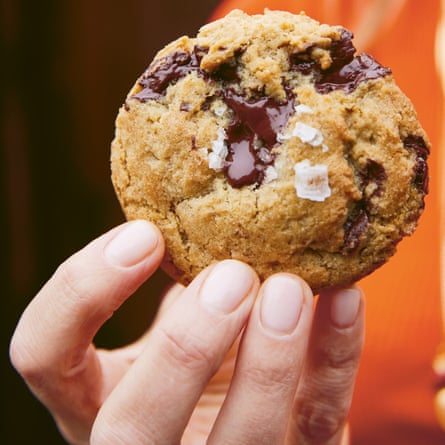
A chewy, gooey chocolate chip cookie that is totally plant-based and totally delicious. I wanted to create a cookie for our vegan friends that was as good as our beloved egg-yolk chocolate chip cookies. In other words, a cookie for vegans with plenty of sugar and white flour. Not all vegans want healthy bakes, so this one is for them.
Makes 18 cookies
ground flaxseeds 1 tbsp
oat milk 60g
plain flour 455g
rolled oats 60g
baking powder 1¼ tsp
bicarbonate of soda 1 tsp
fine sea salt 1 tsp
plant-based butter 250g
soft light brown sugar 250g
caster sugar 150g
vanilla extract 1 tsp
vegan chocolate 250g, broken into 1cm pieces
flaky sea salt to finish
Soak the ground flaxseeds in the oat milk and set aside.
Whisk together the flour, oats, baking powder, bicarb and salt in a bowl and set aside.
In the bowl of a stand mixer fitted with the paddle attachment, beat the vegan butter and both sugars until creamy. Beat in the flax mixture and the vanilla, then add the dry ingredients and mix until just combined. Finally, add the chocolate and mix once again.
Use an ice-cream scoop to portion out 18 cookies on to a tray, or form golf-ball sized amounts of cookie dough using 2 tablespoons. Chill or freeze for at least 1 hour. (You can store the unbaked cookies in the freezer and bake as needed.)
When ready to bake, preheat the oven to 170C fan/gas mark 5. Line 1 or 2 large baking sheets with baking paper and arrange the dough evenly on the trays, leaving enough space between each one so they have room to expand during baking (they almost double in size). If you are baking from frozen, allow the cookies 5 minutes out of the freezer before placing in the oven.
Sprinkle a few flakes of sea salt over the top of each cookie, then bake for 12-14 minutes until the centre of each cookie is slightly soft and underbaked but the edges are crisp and golden. Remove from the oven and allow to cool on the tray for 10 minutes before eating.
Treacle tart with whipped cream
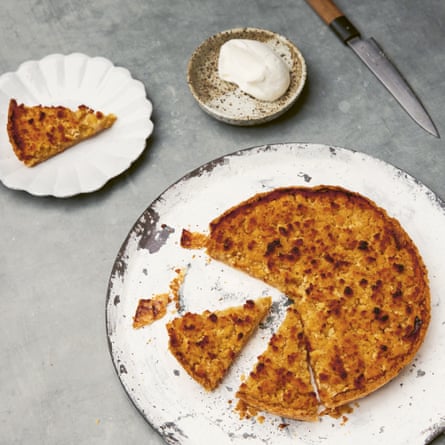
The first time I tasted this very British dessert was at St John Bread and Wine almost 20 years ago. It’s very rich but fantastic. I love the chewy texture and the hint of lemon in the butterscotch-y filling. I add a dash of vodka to mine in order to cut the sweetness down a little. You can play with the citrus here and use mandarin, meyer lemon, or even lime. I have tried to make it with various types of bread – sourdough is a no-no. I love it best with a pain de mie.
Serves 8
For the pastry
plain flour 140g
fine sea salt ⅛ tsp
caster sugar ½ tsp
unsalted butter 115g, chilled and diced
iced water 2 tbsp
For the filling
fresh breadcrumbs 200g, from a slightly stale loaf of white bread
golden syrup 800g
lemon, lime, orange or mandarin juice of 1 large
vanilla extract 2 tsp
vodka 1 tbsp (optional)
flaky sea salt ½ tsp
unsweetened whipped cream to serve
Grease a 25cm loose-bottomed tart tin. Put the flour, salt and sugar into a food processor and blitz to combine. Add the cold butter and pulse until it resembles coarse breadcrumbs. Drizzle in the iced water (you may not need it all) just until it comes together into a ball. Press the dough into a disc, wrap in clingfilm and chill in the fridge for 20 minutes.
Lightly flour a work surface and turn the dough out on to it. Roll it out into a 28cm circle. Carefully lift and lower this into the tart tin, pressing it gently to line the base and sides of the tin. Trim off any excess dough, then chill in the fridge or freezer for at least 30 minutes, or until ready to use.
Meanwhile, prepare the filling. Tip the breadcrumbs into a large bowl, add the remaining ingredients and stir well. Set aside to allow the bread to soak up the syrup. Meanwhile, preheat the oven to 180C fan/gas mark 6.
When ready to bake, loosely cover the case with a piece of baking paper and fill with ceramic baking beans or dried beans. Bake for 15 minutes, then remove the paper and beans and return to the oven for another 10 minutes until the pastry is golden brown.
Tip the filling into the hot tart case; it should come near to the edge of the pastry. Cook for a further 25-30 minutes until the filling has set and turned a light toffee shade. Allow the tart to cool before removing from the tin. Serve with unsweetened whipped cream.
Love is a Pink Cake by Claire Ptak (Vintage Publishing, £27). To support the Guardian and Observer, order your copy atguardianbookshop.com. Delivery charges may apply.

